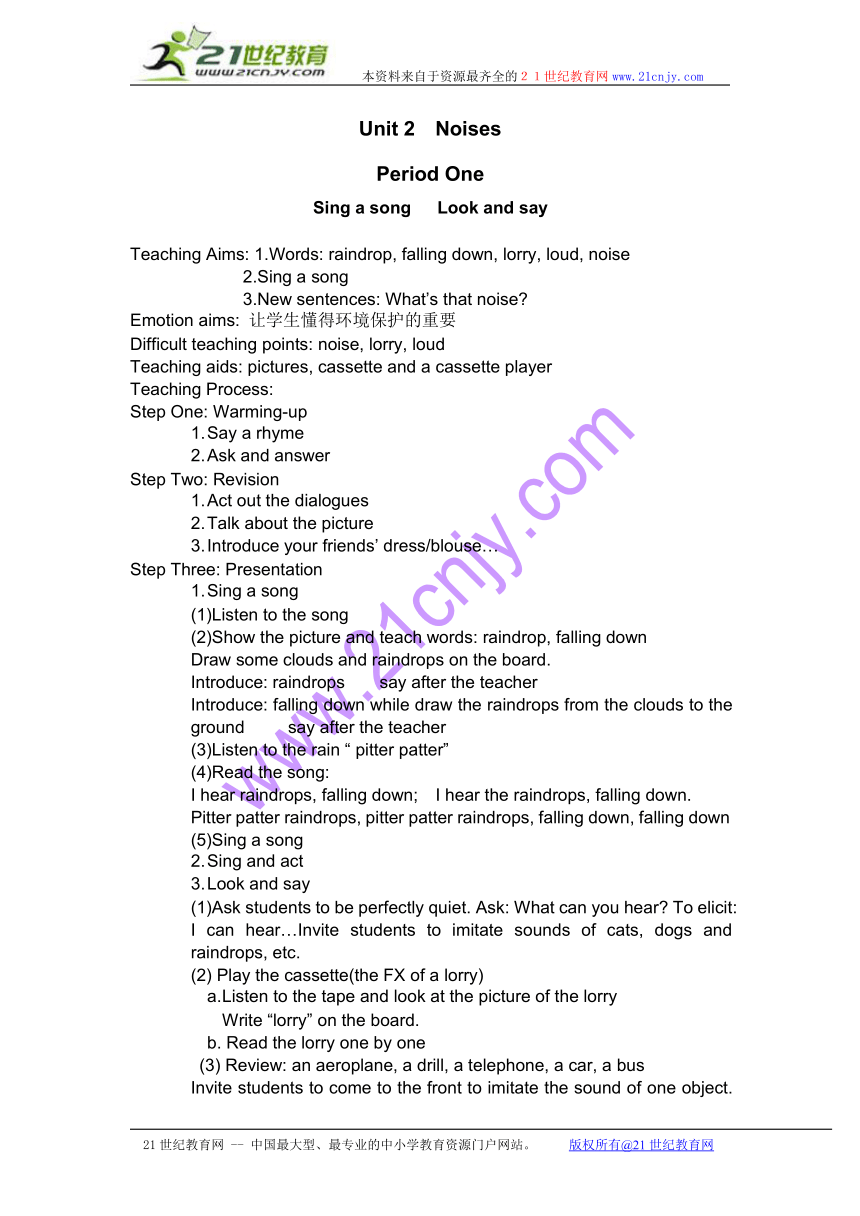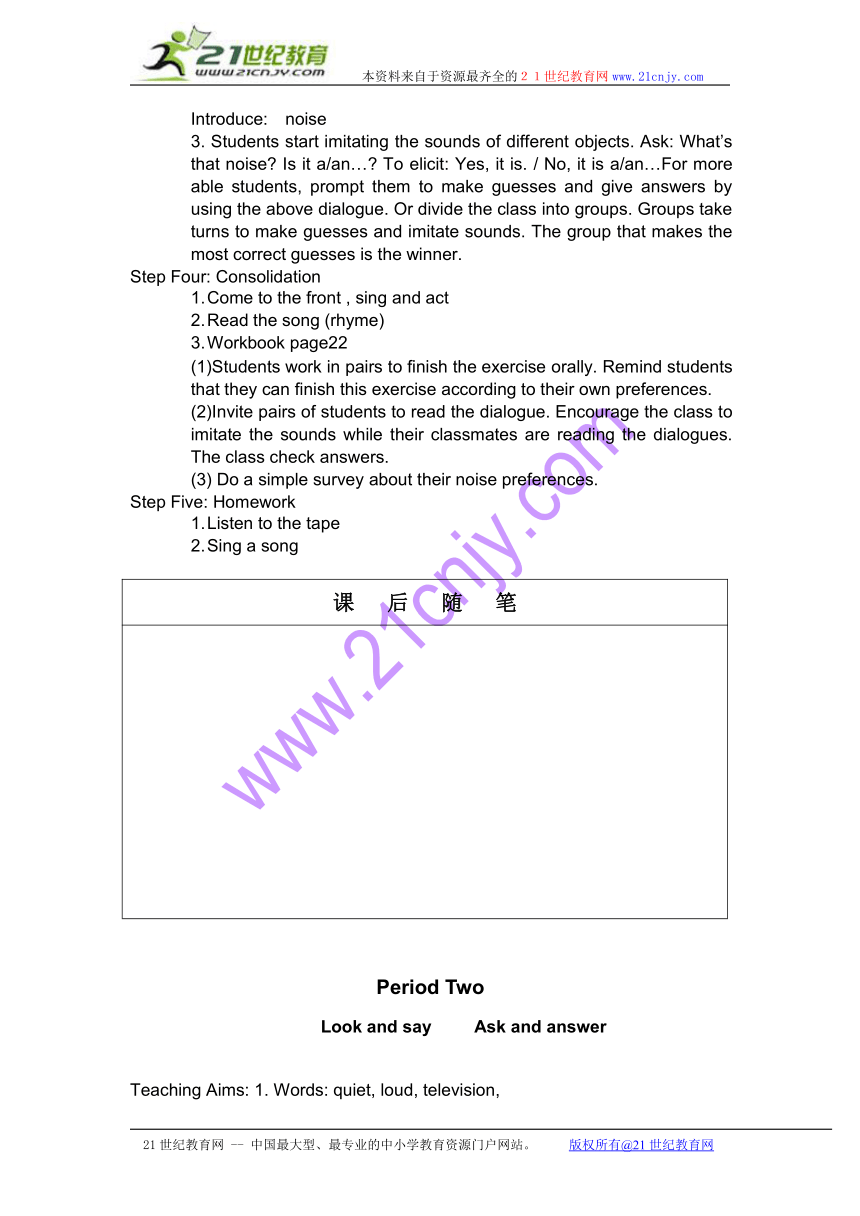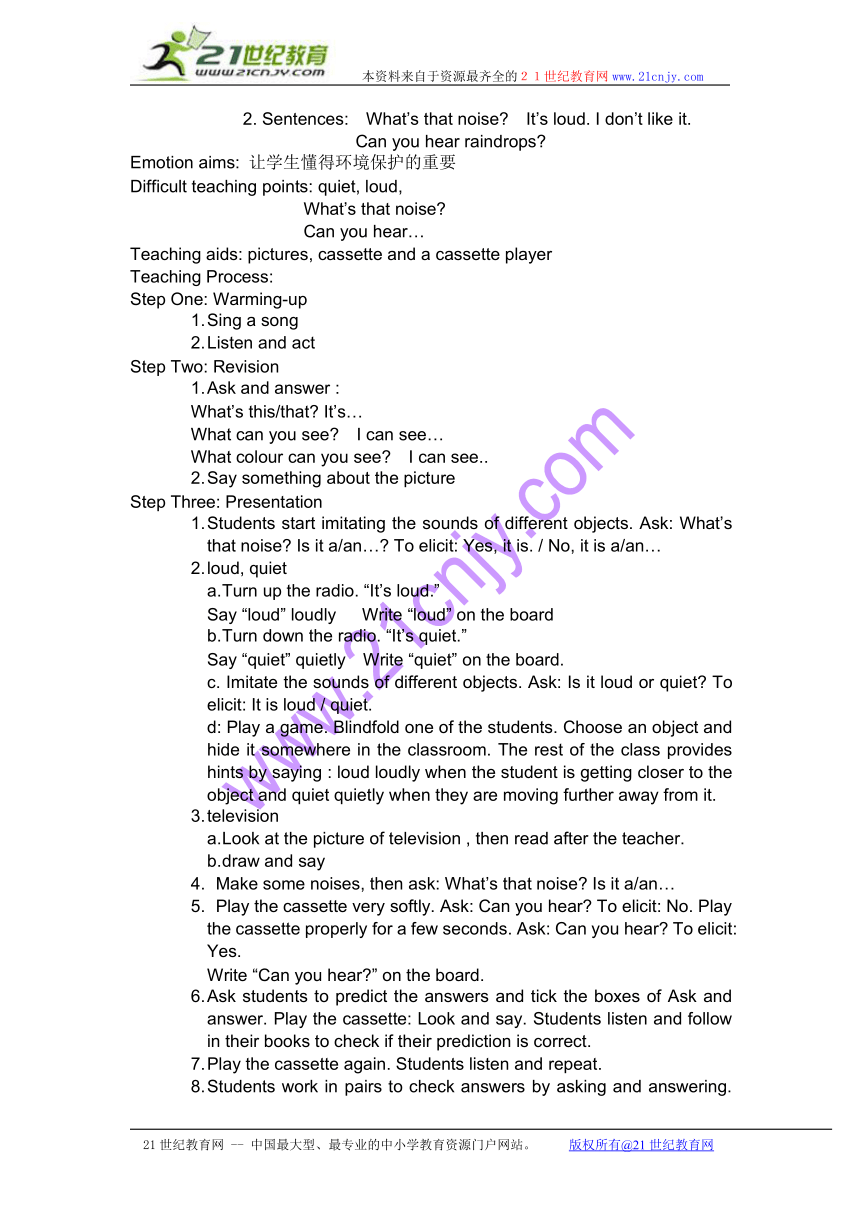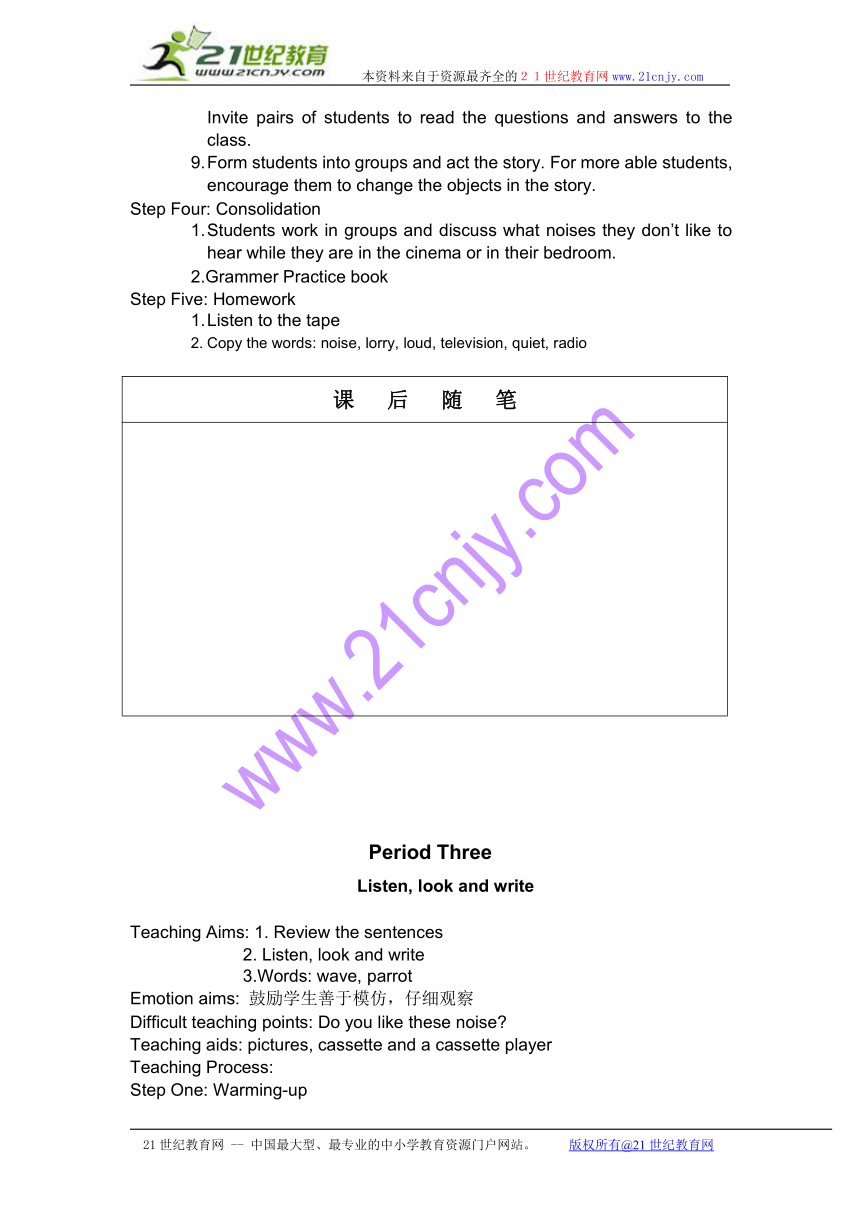三年级牛津英语教案 3b module3 unit2(沪教版)
文档属性
| 名称 | 三年级牛津英语教案 3b module3 unit2(沪教版) |  | |
| 格式 | rar | ||
| 文件大小 | 17.8KB | ||
| 资源类型 | 教案 | ||
| 版本资源 | 上海牛津(绿色上教版) | ||
| 科目 | 英语 | ||
| 更新时间 | 2010-02-25 20:36:00 | ||
图片预览




文档简介
本资料来自于资源最齐全的21世纪教育网www.21cnjy.com
Unit 2 Noises
Period One
Sing a song Look and say
Teaching Aims: 1.Words: raindrop, falling down, lorry, loud, noise
2.Sing a song
3.New sentences: What’s that noise
Emotion aims: 让学生懂得环境保护的重要
Difficult teaching points: noise, lorry, loud
Teaching aids: pictures, cassette and a cassette player
Teaching Process:
Step One: Warming-up
1. Say a rhyme
2. Ask and answer
Step Two: Revision
1. Act out the dialogues
2. Talk about the picture
3. Introduce your friends’ dress/blouse…
Step Three: Presentation
1. Sing a song
(1)Listen to the song
(2)Show the picture and teach words: raindrop, falling down
Draw some clouds and raindrops on the board.
Introduce: raindrops say after the teacher
Introduce: falling down while draw the raindrops from the clouds to the ground say after the teacher
(3)Listen to the rain “ pitter patter”
(4)Read the song:
I hear raindrops, falling down; I hear the raindrops, falling down.
Pitter patter raindrops, pitter patter raindrops, falling down, falling down
(5)Sing a song
2. Sing and act
3. Look and say
(1)Ask students to be perfectly quiet. Ask: What can you hear To elicit: I can hear…Invite students to imitate sounds of cats, dogs and raindrops, etc.
(2) Play the cassette(the FX of a lorry)
a. Listen to the tape and look at the picture of the lorry
Write “lorry” on the board.
b. Read the lorry one by one
(3) Review: an aeroplane, a drill, a telephone, a car, a bus
Invite students to come to the front to imitate the sound of one object. Introduce: noise
3. Students start imitating the sounds of different objects. Ask: What’s that noise Is it a/an… To elicit: Yes, it is. / No, it is a/an…For more able students, prompt them to make guesses and give answers by using the above dialogue. Or divide the class into groups. Groups take turns to make guesses and imitate sounds. The group that makes the most correct guesses is the winner.
Step Four: Consolidation
1. Come to the front , sing and act
2. Read the song (rhyme)
3. Workbook page22
(1)Students work in pairs to finish the exercise orally. Remind students that they can finish this exercise according to their own preferences.
(2)Invite pairs of students to read the dialogue. Encourage the class to imitate the sounds while their classmates are reading the dialogues. The class check answers.
(3) Do a simple survey about their noise preferences.
Step Five: Homework
1. Listen to the tape
2. Sing a song
课 后 随 笔
Period Two
Look and say Ask and answer
Teaching Aims: 1. Words: quiet, loud, television,
2. Sentences: What’s that noise It’s loud. I don’t like it.
Can you hear raindrops
Emotion aims: 让学生懂得环境保护的重要
Difficult teaching points: quiet, loud,
What’s that noise
Can you hear…
Teaching aids: pictures, cassette and a cassette player
Teaching Process:
Step One: Warming-up
1. Sing a song
2. Listen and act
Step Two: Revision
1. Ask and answer :
What’s this/that It’s…
What can you see I can see…
What colour can you see I can see..
2. Say something about the picture
Step Three: Presentation
1. Students start imitating the sounds of different objects. Ask: What’s that noise Is it a/an… To elicit: Yes, it is. / No, it is a/an…
2. loud, quiet
a. Turn up the radio. “It’s loud.”
Say “loud” loudly Write “loud” on the board
b. Turn down the radio. “It’s quiet.”
Say “quiet” quietly Write “quiet” on the board.
c. Imitate the sounds of different objects. Ask: Is it loud or quiet To elicit: It is loud / quiet.
d: Play a game. Blindfold one of the students. Choose an object and hide it somewhere in the classroom. The rest of the class provides hints by saying : loud loudly when the student is getting closer to the object and quiet quietly when they are moving further away from it.
3. television
a. Look at the picture of television , then read after the teacher.
b. draw and say
4. Make some noises, then ask: What’s that noise Is it a/an…
5. Play the cassette very softly. Ask: Can you hear To elicit: No. Play the cassette properly for a few seconds. Ask: Can you hear To elicit: Yes.
Write “Can you hear ” on the board.
6. Ask students to predict the answers and tick the boxes of Ask and answer. Play the cassette: Look and say. Students listen and follow in their books to check if their prediction is correct.
7. Play the cassette again. Students listen and repeat.
8. Students work in pairs to check answers by asking and answering. Invite pairs of students to read the questions and answers to the class.
9. Form students into groups and act the story. For more able students, encourage them to change the objects in the story.
Step Four: Consolidation
1. Students work in groups and discuss what noises they don’t like to hear while they are in the cinema or in their bedroom.
2.Grammer Practice book
Step Five: Homework
1. Listen to the tape
2. Copy the words: noise, lorry, loud, television, quiet, radio
课 后 随 笔
Period Three
Listen, look and write
Teaching Aims: 1. Review the sentences
2. Listen, look and write
3.Words: wave, parrot
Emotion aims: 鼓励学生善于模仿,仔细观察
Difficult teaching points: Do you like these noise
Teaching aids: pictures, cassette and a cassette player
Teaching Process:
Step One: Warming-up
1. Listen and act
2. Sing a song
Step Two: Revision
1. Ask and answer
2. Read the words and spell the words: lorry, loud, raindrop, noise, quiet…
3. Act out the dialogue
Step Three: Presentation
1. Invite students to imitate the sounds of the different objects on page 34.
Ask: What’s that noise Is it a … To elicit: Yes, it is./ No, it is a/an…
Ask: Is it quiet or loud To elicit: It is loud./ It’s quiet.
2. Teaching “wave, parrot”
(1)Show the picture and Listen to the waves
Introduce: wave write “wave” on the board
Imitate the sounds of the wave.
(2)T: Listen to the sound, what can you hear ( hello, hello..)
Show a picture of a parrot:
This is Dotty. Dotty is a parrot. I can hear the parrot.
Sing a song
Say the sentence as a parrot: Hello, hello! I’m a parrot.
(3) Make a dialogue use the new word ”wave” & ”parrot”
eg: What can you hear
I can hear a parrot.
Is this your parrot
No, it’s her parrot.
3. Games: What can you hear
I can hear an aeroplane. ( a drill, waves, a dog, a cat, a bird, a duck, a hen, a parrot…)
4. Do you like these noises
Play the cassette again. Ask: Do you like this noise After each FX to elicit: I like it. / I don’t like it.
5. Divide students into pairs. Students ask each other whether they like a certain noise or not. Ask students to use a different coloured pencil to record the answers.
Students check their recordings against their partner’s.
6. For more able students, divide them into groups. Prompt them to ask their group members: Do you like this noise And find out the most popular noise in their group.
Step Four: Consolidation
1. Listen to the tape
2. Invite individual students to talk about noises they like or dislike. Ask: Do you like this noise by pointing at a certain picture to elicit: I like it./I don’t like it.
3. Ask students to group the noise according to their likes and dislikes. Ask students to make guesses and write down whether they think that a noise is loud or quiet.
4. Make a short dialogues and act out it.
5. Workbook page23,24
Step Five: Homework
1. Listen to the tape
2. Write down the sentences
课 后 随 笔
Period Four
Look and write Learn the sound
Teaching aims: 1. Learn the sound /ju:/
2. Ask and answer
Emotion aims: 让学生学会仔细观察,懂得环境保护的重要
Difficult teaching points: Is this noise loud/quiet Yes, it is./No, it isn’t.
Do you like this noise Yes, I like it./ No, I don’t like it.
Teaching aids: pictures, cassette and a cassette player
Teaching Process:
Step One: Warming-up
1. Sing a song
2. Ask and answer
Step Two: Revision
1. Ask and answer
T: What’s that noise Is it an aeroplane
Do you like the noise Can you hear a drill
Can Kitty hear a dog
2. Listen to the tape
Do you like these noises
Step Three: Presentation
1. Introduce: loud quite
T: Turn up the radio and say “It’s loud.” Turn down the radio and say “It’s quite.”
Write on the blackboard: loud quite
2. Invite students to imitate sounds of different animals or different object.
3. (1)Invite individual students to come to the board and make any noise they like. Remind these students that they can make the noise loud or quiet.
(2)Ask : What’s that noise To elicit: It is…
4. Is this noise loud/quiet Do you like this noise To elicit: Yes, it is. No, it isn’t. Yes, I like it. No, I don’t like it.
5. Play the cassette. Students listen and tick the boxes to show whether the noises are loud or quiet. Ask students to draw happy or sad faces beside each illustration to show whether they like or dislike the noise.
6. Students work in pairs to check answers and find out whether their partner likes or dislikes the noises by using the dialogue. Students take turns to ask: Is this noise loud/quiet Do you
like this noise And answer: Yes, it is. No, it isn’t. Yes, I like it. No, I don’t like it.
7. Ask and answer
S1: Is this noise loud / quite S2: Yes, it is. / No, it isn’t.
S1: Do you like this noise S2: Yes, I like it. / No, I don’t like it.
a. Work in pair
b. Act out the dialogue
8. Learn the sound /ju:/
(1)_T: Look at the picture, what are you doing I’m listening to the beautiful music. It is super. Do you like it” Yes, I do.(show the card)
(2) I like the beautiful music. It is super.
(pay attention the sound /ju:/)
(3) Find out the words of the sound /ju:/
(4) Read the sentences loud
Step Four: Consolidation
1. Listen to the tape
2. Read the sentences
3. Do the exercises
Step Five: Homework
1. Listen to the tape and say it by yourself
2. Work book
课 后 随 笔
21世纪教育网 -- 中国最大型、最专业的中小学教育资源门户网站。 版权所有@21世纪教育网
Unit 2 Noises
Period One
Sing a song Look and say
Teaching Aims: 1.Words: raindrop, falling down, lorry, loud, noise
2.Sing a song
3.New sentences: What’s that noise
Emotion aims: 让学生懂得环境保护的重要
Difficult teaching points: noise, lorry, loud
Teaching aids: pictures, cassette and a cassette player
Teaching Process:
Step One: Warming-up
1. Say a rhyme
2. Ask and answer
Step Two: Revision
1. Act out the dialogues
2. Talk about the picture
3. Introduce your friends’ dress/blouse…
Step Three: Presentation
1. Sing a song
(1)Listen to the song
(2)Show the picture and teach words: raindrop, falling down
Draw some clouds and raindrops on the board.
Introduce: raindrops say after the teacher
Introduce: falling down while draw the raindrops from the clouds to the ground say after the teacher
(3)Listen to the rain “ pitter patter”
(4)Read the song:
I hear raindrops, falling down; I hear the raindrops, falling down.
Pitter patter raindrops, pitter patter raindrops, falling down, falling down
(5)Sing a song
2. Sing and act
3. Look and say
(1)Ask students to be perfectly quiet. Ask: What can you hear To elicit: I can hear…Invite students to imitate sounds of cats, dogs and raindrops, etc.
(2) Play the cassette(the FX of a lorry)
a. Listen to the tape and look at the picture of the lorry
Write “lorry” on the board.
b. Read the lorry one by one
(3) Review: an aeroplane, a drill, a telephone, a car, a bus
Invite students to come to the front to imitate the sound of one object. Introduce: noise
3. Students start imitating the sounds of different objects. Ask: What’s that noise Is it a/an… To elicit: Yes, it is. / No, it is a/an…For more able students, prompt them to make guesses and give answers by using the above dialogue. Or divide the class into groups. Groups take turns to make guesses and imitate sounds. The group that makes the most correct guesses is the winner.
Step Four: Consolidation
1. Come to the front , sing and act
2. Read the song (rhyme)
3. Workbook page22
(1)Students work in pairs to finish the exercise orally. Remind students that they can finish this exercise according to their own preferences.
(2)Invite pairs of students to read the dialogue. Encourage the class to imitate the sounds while their classmates are reading the dialogues. The class check answers.
(3) Do a simple survey about their noise preferences.
Step Five: Homework
1. Listen to the tape
2. Sing a song
课 后 随 笔
Period Two
Look and say Ask and answer
Teaching Aims: 1. Words: quiet, loud, television,
2. Sentences: What’s that noise It’s loud. I don’t like it.
Can you hear raindrops
Emotion aims: 让学生懂得环境保护的重要
Difficult teaching points: quiet, loud,
What’s that noise
Can you hear…
Teaching aids: pictures, cassette and a cassette player
Teaching Process:
Step One: Warming-up
1. Sing a song
2. Listen and act
Step Two: Revision
1. Ask and answer :
What’s this/that It’s…
What can you see I can see…
What colour can you see I can see..
2. Say something about the picture
Step Three: Presentation
1. Students start imitating the sounds of different objects. Ask: What’s that noise Is it a/an… To elicit: Yes, it is. / No, it is a/an…
2. loud, quiet
a. Turn up the radio. “It’s loud.”
Say “loud” loudly Write “loud” on the board
b. Turn down the radio. “It’s quiet.”
Say “quiet” quietly Write “quiet” on the board.
c. Imitate the sounds of different objects. Ask: Is it loud or quiet To elicit: It is loud / quiet.
d: Play a game. Blindfold one of the students. Choose an object and hide it somewhere in the classroom. The rest of the class provides hints by saying : loud loudly when the student is getting closer to the object and quiet quietly when they are moving further away from it.
3. television
a. Look at the picture of television , then read after the teacher.
b. draw and say
4. Make some noises, then ask: What’s that noise Is it a/an…
5. Play the cassette very softly. Ask: Can you hear To elicit: No. Play the cassette properly for a few seconds. Ask: Can you hear To elicit: Yes.
Write “Can you hear ” on the board.
6. Ask students to predict the answers and tick the boxes of Ask and answer. Play the cassette: Look and say. Students listen and follow in their books to check if their prediction is correct.
7. Play the cassette again. Students listen and repeat.
8. Students work in pairs to check answers by asking and answering. Invite pairs of students to read the questions and answers to the class.
9. Form students into groups and act the story. For more able students, encourage them to change the objects in the story.
Step Four: Consolidation
1. Students work in groups and discuss what noises they don’t like to hear while they are in the cinema or in their bedroom.
2.Grammer Practice book
Step Five: Homework
1. Listen to the tape
2. Copy the words: noise, lorry, loud, television, quiet, radio
课 后 随 笔
Period Three
Listen, look and write
Teaching Aims: 1. Review the sentences
2. Listen, look and write
3.Words: wave, parrot
Emotion aims: 鼓励学生善于模仿,仔细观察
Difficult teaching points: Do you like these noise
Teaching aids: pictures, cassette and a cassette player
Teaching Process:
Step One: Warming-up
1. Listen and act
2. Sing a song
Step Two: Revision
1. Ask and answer
2. Read the words and spell the words: lorry, loud, raindrop, noise, quiet…
3. Act out the dialogue
Step Three: Presentation
1. Invite students to imitate the sounds of the different objects on page 34.
Ask: What’s that noise Is it a … To elicit: Yes, it is./ No, it is a/an…
Ask: Is it quiet or loud To elicit: It is loud./ It’s quiet.
2. Teaching “wave, parrot”
(1)Show the picture and Listen to the waves
Introduce: wave write “wave” on the board
Imitate the sounds of the wave.
(2)T: Listen to the sound, what can you hear ( hello, hello..)
Show a picture of a parrot:
This is Dotty. Dotty is a parrot. I can hear the parrot.
Sing a song
Say the sentence as a parrot: Hello, hello! I’m a parrot.
(3) Make a dialogue use the new word ”wave” & ”parrot”
eg: What can you hear
I can hear a parrot.
Is this your parrot
No, it’s her parrot.
3. Games: What can you hear
I can hear an aeroplane. ( a drill, waves, a dog, a cat, a bird, a duck, a hen, a parrot…)
4. Do you like these noises
Play the cassette again. Ask: Do you like this noise After each FX to elicit: I like it. / I don’t like it.
5. Divide students into pairs. Students ask each other whether they like a certain noise or not. Ask students to use a different coloured pencil to record the answers.
Students check their recordings against their partner’s.
6. For more able students, divide them into groups. Prompt them to ask their group members: Do you like this noise And find out the most popular noise in their group.
Step Four: Consolidation
1. Listen to the tape
2. Invite individual students to talk about noises they like or dislike. Ask: Do you like this noise by pointing at a certain picture to elicit: I like it./I don’t like it.
3. Ask students to group the noise according to their likes and dislikes. Ask students to make guesses and write down whether they think that a noise is loud or quiet.
4. Make a short dialogues and act out it.
5. Workbook page23,24
Step Five: Homework
1. Listen to the tape
2. Write down the sentences
课 后 随 笔
Period Four
Look and write Learn the sound
Teaching aims: 1. Learn the sound /ju:/
2. Ask and answer
Emotion aims: 让学生学会仔细观察,懂得环境保护的重要
Difficult teaching points: Is this noise loud/quiet Yes, it is./No, it isn’t.
Do you like this noise Yes, I like it./ No, I don’t like it.
Teaching aids: pictures, cassette and a cassette player
Teaching Process:
Step One: Warming-up
1. Sing a song
2. Ask and answer
Step Two: Revision
1. Ask and answer
T: What’s that noise Is it an aeroplane
Do you like the noise Can you hear a drill
Can Kitty hear a dog
2. Listen to the tape
Do you like these noises
Step Three: Presentation
1. Introduce: loud quite
T: Turn up the radio and say “It’s loud.” Turn down the radio and say “It’s quite.”
Write on the blackboard: loud quite
2. Invite students to imitate sounds of different animals or different object.
3. (1)Invite individual students to come to the board and make any noise they like. Remind these students that they can make the noise loud or quiet.
(2)Ask : What’s that noise To elicit: It is…
4. Is this noise loud/quiet Do you like this noise To elicit: Yes, it is. No, it isn’t. Yes, I like it. No, I don’t like it.
5. Play the cassette. Students listen and tick the boxes to show whether the noises are loud or quiet. Ask students to draw happy or sad faces beside each illustration to show whether they like or dislike the noise.
6. Students work in pairs to check answers and find out whether their partner likes or dislikes the noises by using the dialogue. Students take turns to ask: Is this noise loud/quiet Do you
like this noise And answer: Yes, it is. No, it isn’t. Yes, I like it. No, I don’t like it.
7. Ask and answer
S1: Is this noise loud / quite S2: Yes, it is. / No, it isn’t.
S1: Do you like this noise S2: Yes, I like it. / No, I don’t like it.
a. Work in pair
b. Act out the dialogue
8. Learn the sound /ju:/
(1)_T: Look at the picture, what are you doing I’m listening to the beautiful music. It is super. Do you like it” Yes, I do.(show the card)
(2) I like the beautiful music. It is super.
(pay attention the sound /ju:/)
(3) Find out the words of the sound /ju:/
(4) Read the sentences loud
Step Four: Consolidation
1. Listen to the tape
2. Read the sentences
3. Do the exercises
Step Five: Homework
1. Listen to the tape and say it by yourself
2. Work book
课 后 随 笔
21世纪教育网 -- 中国最大型、最专业的中小学教育资源门户网站。 版权所有@21世纪教育网
同课章节目录
- Module 1 Using my five senses
- Unit 1 Looking and seeing
- Unit 2 Listening and hearing
- Unit 3 Touching and feeling
- Unit 4 Tasting and smelling
- Module 2 My favourite things
- Unit 1 Animals I like
- Unit 2 Toys I like
- Unit 3 People I like
- Module 3 Things around us
- Unit 1 Colours
- Unit 2 Noises
- Unit 3 The seasons
